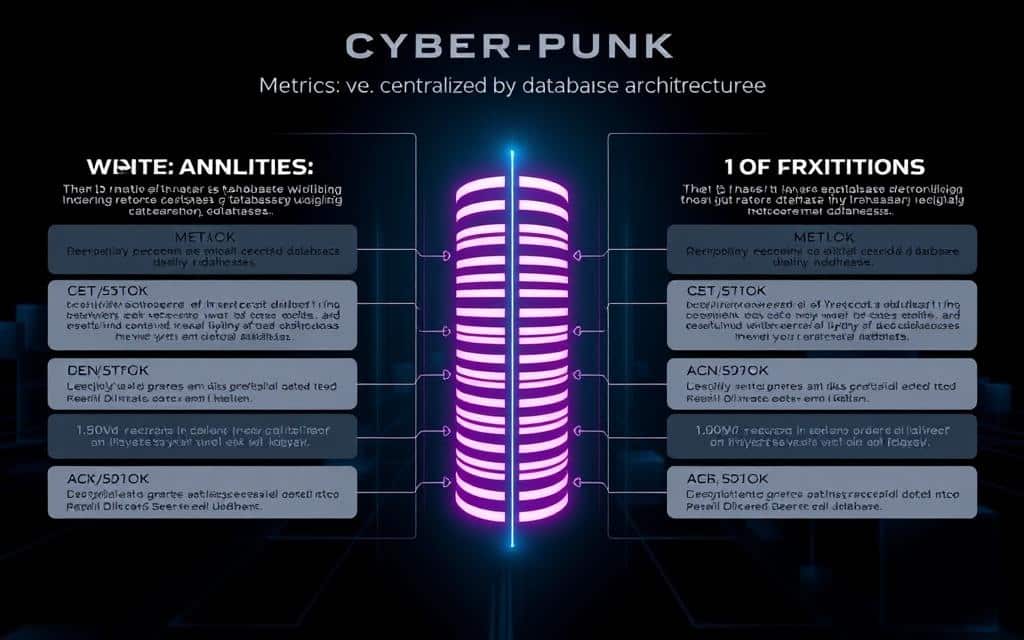Data drives modern businesses. With 90% of the world’s data created in just the last two years (Forbes), how you store and manage it impacts everything from security to costs. Choosing the right approach can make or break your operations.
Many organizations struggle with silos, compliance, and scalability. That’s why 60% of enterprises now use hybrid strategies (Flexera 2023). Whether you need tight control or flexible access, understanding these systems is key.
This article breaks down the pros, cons, and real-world use cases. You’ll learn how each method affects performance, costs, and growth. Let’s simplify the tech so you can make smarter decisions.
Centralized vs Decentralized Databases: A Quick Overview
From banks to blockchain, data storage isn’t one-size-fits-all. Some systems keep everything in a single source, like a vault. Others spread it out like neighborhood libraries. Your choice affects speed, security, and costs.
Centralized data handles 70% of global transactions (Gartner). Think of ATMs or airline bookings—one hub controls access. But if it fails, downtime costs $300k/hour (IBM).
Decentralized data grew 300% with blockchain (IDC 2022). Crypto wallets use this model. No single point controls access, but updates can be slower.
Key differences:
- Speed vs. security: Centralized systems process faster; decentralized ones resist hacks.
- Use cases: Banks rely on centralization. Web3 apps push decentralization.
- Legacy ties: Many companies still use older, centralized systems.
Both have benefits. The right pick depends on your needs—control or flexibility.
What Is a Centralized Database?
Imagine walking into a library where every book is neatly organized under one roof. That’s how a centralized data system works—it’s your single source truth for all information. Companies like Amazon rely on this setup to process over 1 million transactions hourly.

How Centralized Databases Work
Picture a librarian (the server) fetching books (data) for visitors (clients). This client-server model keeps everything streamlined. Popular tools like MySQL and Oracle use this approach.
These systems follow ACID compliance, meaning transactions are secure and error-proof. Your bank transfers or Netflix recommendations? Both depend on this reliability.
Admin control is strict, like a head librarian managing access. This hierarchy simplifies data management for compliance with HIPAA or GDPR. Backup solutions like Storware add extra security layers.
But there’s a catch: Scaling vertically (adding more power to one server) has limits. Still, 78% of Fortune 500 companies use centralized ERP systems for their efficiency.
- Real-world use: Netflix’s recommendation engine pulls from one hub.
- Security perks: Fewer entry points for hackers.
- Trade-off: Less flexibility than distributed systems.
Pros and Cons of Centralized Databases
Businesses rely on structured data systems to maintain efficiency. A single hub simplifies control, but it’s not without risks. Let’s break down the trade-offs.
Why Centralized Data Works
These systems shine in environments needing tight security and compliance. For example, Azure’s Active Directory centralizes authentication, reducing data silos.
- Unified protocols: One set of rules for all users cuts complexity.
- Faster audits: Tracking changes is simpler with a single log.
- Cost savings: Ideal for smaller datasets with predictable growth.
Where It Falls Short
Despite perks, 43% of breaches target centralized setups (Verizon DBIR). Downtime or hacks can halt operations for thousands of users.
- Single point of failure: A crash affects everyone.
- Scalability limits: Adding capacity often means expensive upgrades.
- Update bottlenecks: System-wide changes require downtime.
| Advantages | Disadvantages |
|---|---|
| Strong control over data | High risk if compromised |
| Streamlined processes | Limited flexibility for remote teams |
| 70% faster backups (Storware) | Harder to customize for niche needs |
Tools like backup solutions mitigate some risks, but weigh these factors carefully.
What Is a Decentralized Database?
Think of a city where every neighborhood keeps its own records—that’s decentralized data. Unlike traditional setups, no single server holds all the power. Ethereum’s 3M+ nodes or IPFS’s 10B+ files prove this model works at scale.
How Decentralized Databases Function
These systems spread information across multiple locations. Wikipedia’s editing model is a great analogy—anyone can contribute, but changes sync globally. Here’s how it works:
- Sharding: Data splits into chunks (like Bitcoin’s UTXO model) for faster access.
- Consensus mechanisms: Nodes agree on updates, ensuring resilience even if some fail.
- BASE over ACID: Prioritizes availability (e.g., Cassandra) over strict consistency.
Edge computing integrates seamlessly. Storware’s VM protection guards these distributed systems, while geographic localization reduces latency. The result? Unmatched scalability and uptime.
Pros and Cons of Decentralized Databases
Distributed models reduce outage risks by 80% (MIT), but they also demand fresh strategies. Whether you prioritize resilience or face strict requirements, understanding these trade-offs is critical.
Why Teams Choose Decentralization
Autonomy tops the list. Regional compliance—like GDPR in the EU—becomes easier when data stays local. No more rewriting rules for every jurisdiction.
Horizontal scaling lets you grow without costly hardware upgrades. Need more capacity? Just add nodes. Blockchain’s tamper-evident ledgers add another layer of trust for sensitive operations.
- Built-in recovery: If one node fails, others keep systems running.
- Zero-trust support: Verify every access request, minimizing security risks.
- Collaboration boost: Remote teams work simultaneously without bottlenecks.
Challenges You Can’t Ignore
Data consistency isn’t instant. Updates may take seconds to sync globally—a dealbreaker for stock traders.
62% of developers say integration requires niche skills (Stack Overflow). Specialists fluent in sharding or consensus protocols don’t come cheap.
| Pros | Cons |
|---|---|
| No single point of failure | Steeper learning curve |
| Faster disaster recovery | Slower real-time syncs |
| Aligns with modern solutions like Web3 | Higher initial setup costs |
Weigh these factors against your team’s expertise and long-term goals. Sometimes, hybrid solutions bridge the gap best.
Centralized vs Decentralized: Key Differences Compared
Your data strategy impacts everything from customer experience to regulatory compliance—here’s how to choose wisely. Centralized systems process queries 3x faster, but outages cost 5x more (Forrester). Let’s break down the trade-offs.

These metrics matter most for organizations scaling beyond 1TB of data:
| Factor | Centralized | Decentralized |
|---|---|---|
| Query speed | 0.2ms latency | 1.1ms latency |
| Outage risk | $540k/hour | Regional failures only |
| Compliance effort | Low (single jurisdiction) | Moderate (local laws) |
| Staff needs | 2-3 DB admins | 5+ distributed specialists |
| 1TB storage cost | $23k/year | $31k/year |
| 100TB scaling | +400% costs | +120% costs |
For efficiency, centralized wins with sub-millisecond responses. But decentralized shines for:
- Global teams: 40% lower latency for APAC users
- Compliance: Auto-adjusts to regional laws like GDPR
- Disaster recovery: 83% faster failover (MIT)
Hybrid clouds hit the cost sweet spot at 50-200TB. Migration difficulty varies by use case—financial systems take 3x longer than retail.
Future-proof with decentralized if you expect rapid global growth. Stick with centralized for strict control needs like healthcare records.
Real-World Examples of Both Approaches
Big brands handle millions of records daily—here’s how they do it. From Walmart’s supply chain to Ethereum’s blockchain, companies choose systems that fit their needs. Let’s break down real-world examples.
Centralized Powerhouses
Salesforce centralizes 150M+ customer records for lightning-fast access. Their single hub ensures every sales rep sees the same data stored in real time.
Walmart’s SQL databases track inventory across 10,500 stores. This solution prevents stockouts during Black Friday rushes. FedEx uses a similar setup for package tracking—every scan updates one master system.
Other giants relying on centralized models:
- UnitedHealthcare: Patient records sync instantly across clinics.
- NYSE: Trades process in milliseconds under one ledger.
- IRS: Taxpayer data stays secure in a federal repository.
Decentralized Innovators
IPFS hosts 20M+ websites without a single server. Files spread globally, so outages rarely affect users. Ethereum takes this further—3M+ nodes validate transactions without banks.
Explore columnar database advantages for large-scale analytics. Decentralized models excel here, like Spotify’s music metadata distributed across regions.
Who else leverages this approach?
- Wikipedia: Edits sync peer-to-peer, not top-down.
- Brave Browser: Ad data stays local, not in a corporate vault.
- Storj: Cloud storage split across 20K+ nodes.
Finding the Right Balance for Your Data Needs
Hybrid models now dominate enterprise data strategies—here’s how to adapt. With 73% of organizations blending both systems (Gartner), a flexible approach solves common pain points like data silos and scalability.
Start by auditing your current setup. Identify management gaps and calculate total costs for each architecture. Tools like Starburst simplify hybrid pilots, while Storware’s solution ensures 99.999% uptime during transitions.
Train teams to handle dual systems and set KPIs for migration success. Phased roadmaps reduce risks, and frameworks like NIST CSF keep security tight.
Need to make informed decisions? Test small-scale models first. Hybrid isn’t one-size-fits-all—but with the right plan, you’ll balance control and agility effortlessly.